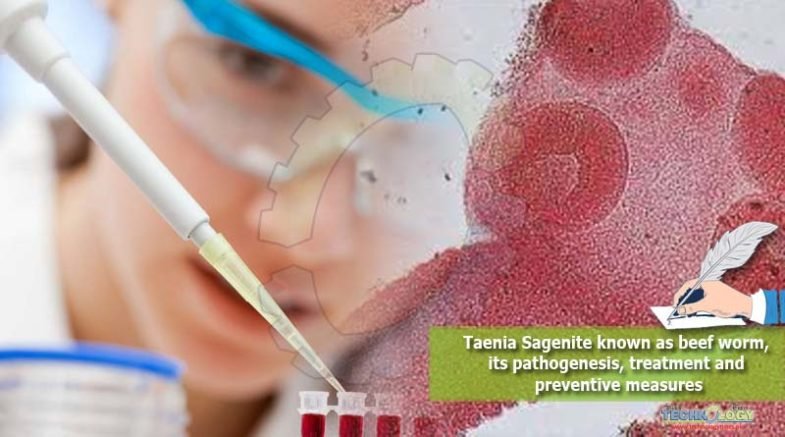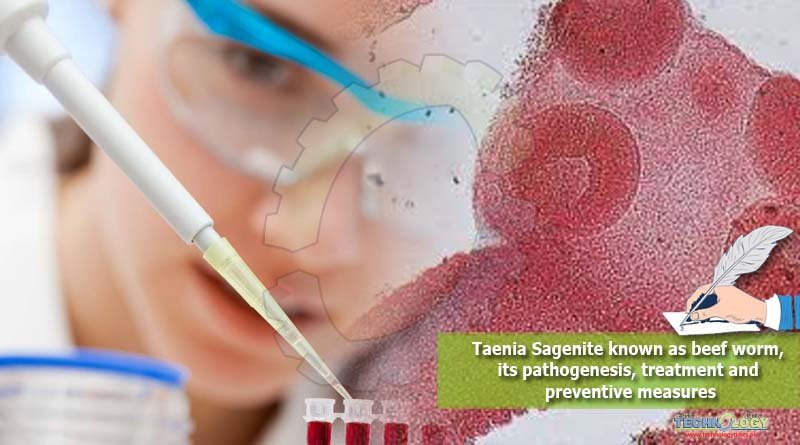Many different worms effect the live stock industry one of the most common is taenia sagenite. It is Commonly named as beef worm, having variety of hosts like cattle as a intermediate host and humans as definative host.
 Livestock industry is considered as major pallor in establishing economy of any country. Livestock sector includes all cattle and buffaloes. Any abnormality that effect animals can cause a severe damage to livestock industry of any country.
Livestock industry is considered as major pallor in establishing economy of any country. Livestock sector includes all cattle and buffaloes. Any abnormality that effect animals can cause a severe damage to livestock industry of any country.
Most common specie(Taeniarhychus Saginatus) named as beef worm and of zoonotic importance belonging to order cyclophyledia and genus taenia. It is parasite of human and cattle causing taeneasis and cysticercosis living mainly in intestine.
Body Structure: Largest specie of its genus about 22m long size has been reported. Mainly cestodes like in body having 3 parts neck, scolex, strobila. NECK shortest pat while SCOLEX has 4 suckers having no hooks and rostellum which is digostic feature of it and STROBLIA has smaller differentiated segments called proglottids having both male and female characters in it.
Proglottids reported to seen 1,000 to 2,000 in single individual.They are acelomates having no body cavity and no digestive system.Due of lack of digestive system Taenia derive food from teguments having hair like structure called microtrichus.
Intermediate Host: Cattle as intermediate host acquire oncospores by contaminated feed which goes into intestine to hatch under the influence of gastric juice to produce six hooks larvae called as hexacanth. These larvae initially settle down in the intestine but later move with blood circulation to go to muscle cells where they cast off there hooks to form protective cuticular shell called cyst. All this happens within 70 days.
Definite Host: By eating contaminated and uncooked food they larvae goes into the intestine of humans and leads to settle by scolex. It become adult in 5-12 weeks and adult worms can live in host for 25 years.In humans as each proglotid has its own fertilizing ability to produce embryonic eggs called oncospores. The proglottid may get separate as old gravid having thousands of eggs or may get burst to release eggs in the intestine.these eggs are removed into environment by peristalsis remain viable on ground for several days to several weeks.
Epidemiology: The disease(cysticercosis and taeniasis) caused by taenia saginatum is commonly seen in Africa,some parts of Europe,Phillipines and Latin America.in USA its incidence is low because 25% of effected cattle are sold but more prevalent in Sub-Sahara areas and Middle East.At global infestation level estimated about 40-60 million mainly where beef worm consumption is high.
Symptoms:
In animals Mainly asymptomatic but heavy infestation can lead to weight loss, dizziness, diphtheria, headache, nausea, In Humans leads to intestinal obstruction which can be treated by surgery.Other complications includes pancreatitis,cholecystitis,cholengitis.
Diagnosis: Mainly done by stool sample but it is difficult to identify the eggs under microscope.the diagnostic feature of taenia is head or scolex and old gravid or proglottids that’s stick into thigh muscles of humans. observation of scolex can be used to distinguish between T. Saginatum, Solidum, T. Ovium.
Other is on the basis of uterus which is injected vinto india by which its branches become visible but differentiation on this base is very difficult because of close resemblance. this can be differentiated by histological base or ribosomal base.
Zehl nelson stain also be used to differentiate but it is not reliable.
Treatment:
- Praziquantel (5-10mg/kg single administration)
- Nicodamid (2g in adults over 6 years, 1g in 2-6 years, 500mg in under 2 years)
- Albendazole can used in cattle.
Prevention:
- Proper cooking of beef at 56C for 5 mints. To destroy cysticerciae
- Freezing beef at-10C for 9 days or long salting duration is lethal for cysticercus.
- Proper Inspection of beef is done
- Proper disposal of human excreta is also important
Authors:
- Dr. Ali Raza,
- Dr. Amjad Ali
